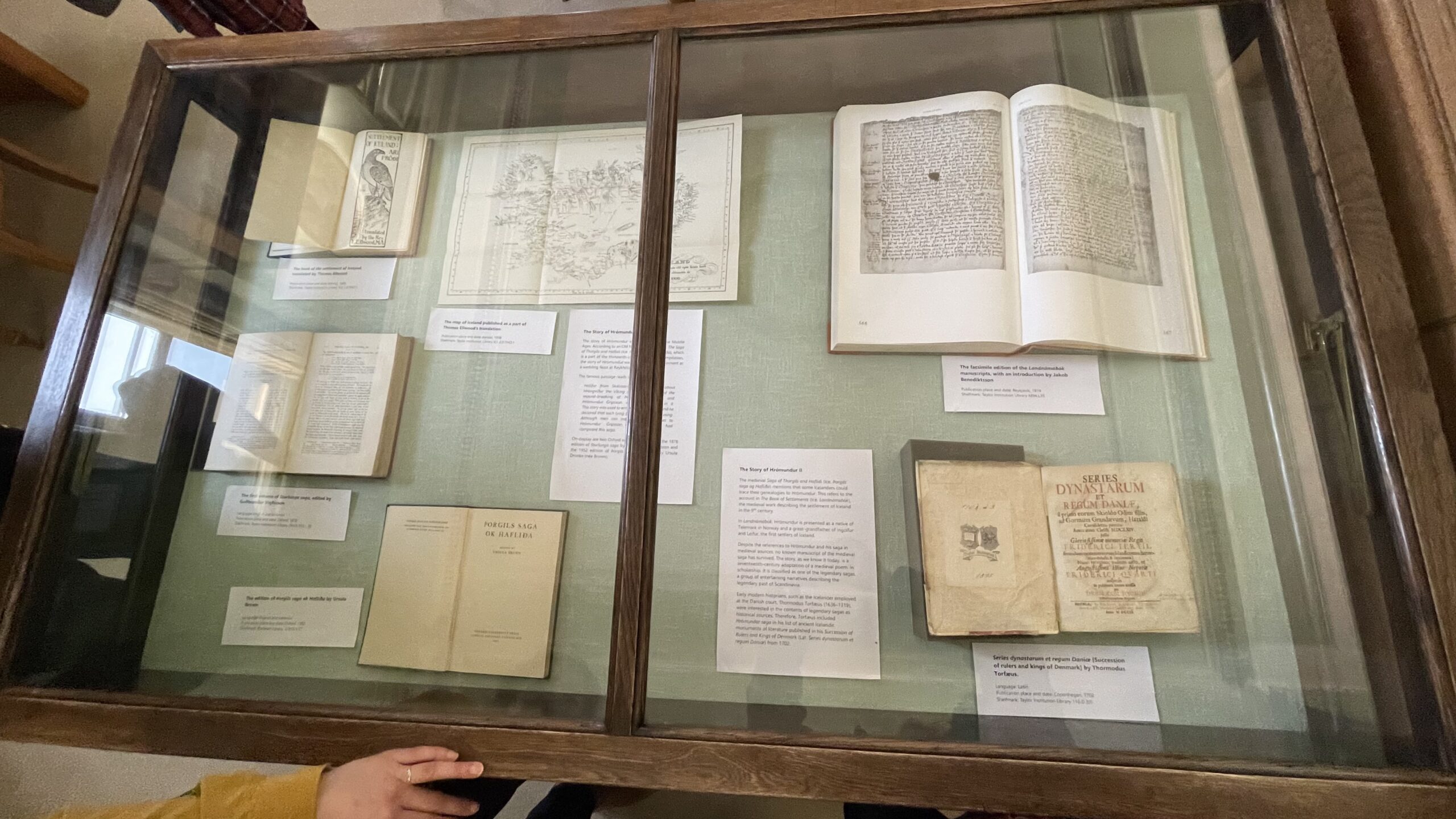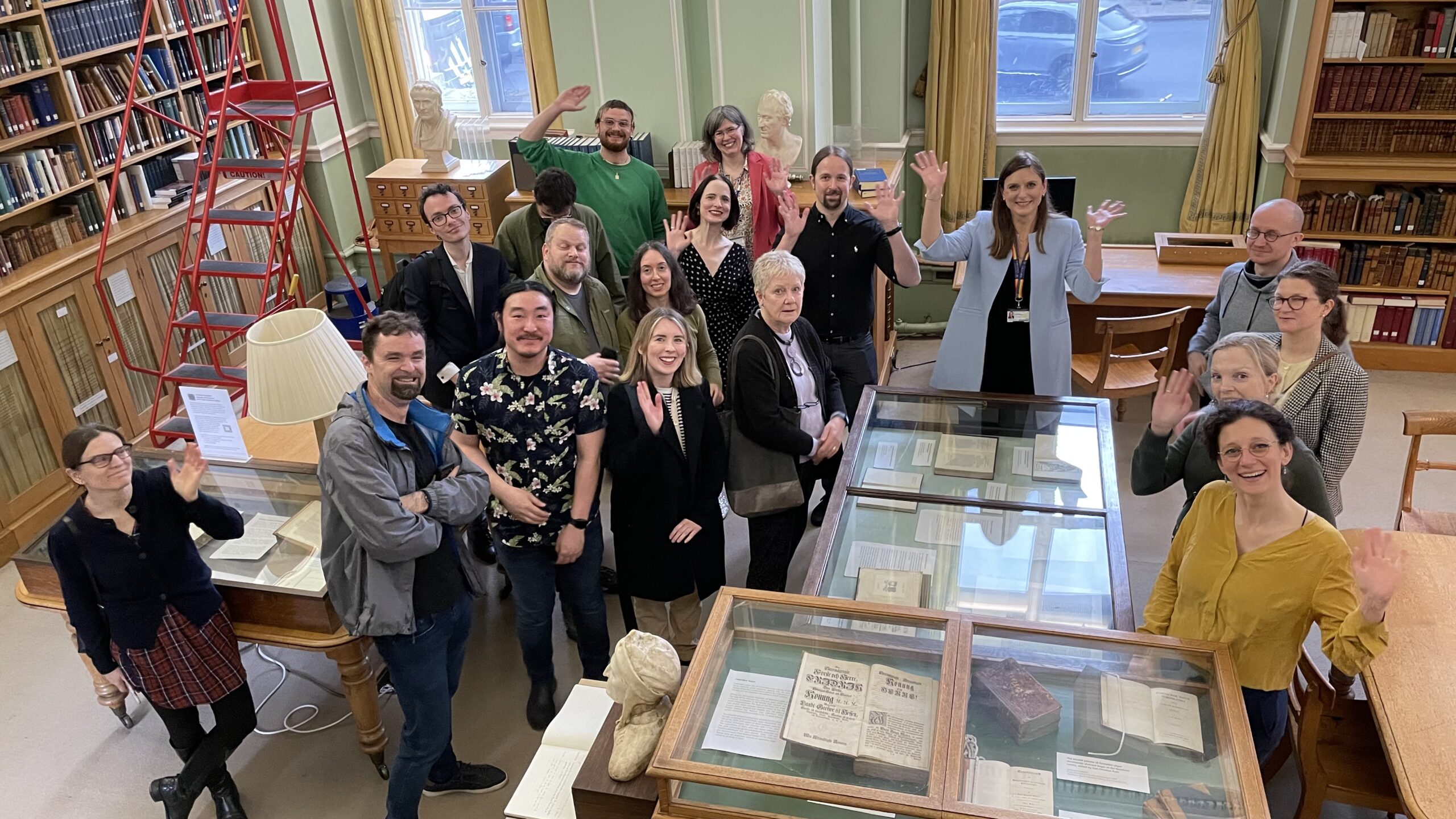by Katarzyna Anna Kapitan
This blog post and book display in the Voltaire Room between 3 and 10 May is a showcase of the excellent range of books on Old Norse-Icelandic language and literature held at the Taylorian. The display accompanies the launch of new digital editions of three versions of an Old Norse-Icelandic saga, Hrómundar saga Greipssonar, in the Taylor Editions series, and the release of an open access study of the saga’s transmission history, Lost but not forgotten: The saga of Hrómundur and its manuscript transmission, by Katarzyna Anna Kapitan.
To limit the number of books on physical display, the exhibit was structured around three themes: Icelandic Language and Literature in Oxford, The Story of Hrómundur, and Legendary Sagas. All items on display are from the holdings of the Taylor Institution Library, unless otherwise specified on the label.
Panel 1: Icelandic Language and Literature in Oxford

The first book on the Icelandic language published in Oxford appeared in 1688. It was a reprint of the 1651 Copenhagen edition of the first early modern grammar of Icelandic by Runólfur Jónsson (d. 1654), an Icelander educated at the University of Copenhagen.
At Oxford, the first formal lectureship in Old Icelandic was established in 1884, to which Guðbrandur Vigfússon (1827–1889) was appointed. Guðbrandur, born and raised in Iceland moved to the UK to supervise the completion of the Icelandic–English dictionary, initiated by Richard Cleasby (1797–1847). He was awarded an honorary M.A. degree by Christ Church in 1871. In Guðbrandur’s memory, the Vigfusson Readership in Ancient Icelandic Literature and Antiquities was established at Oxford, and in 1976 the first woman was elected to this readership, Ursula Dronke, née Brown (1920–2012). Ursula held a professorial fellowship at Linacre College and is best known for her work on the Poetic Edda. In her early days, she was a fellow at Somerville College, where she wrote her B.Litt. thesis on The Saga of Thorgils and Haflidi (Ice. Þorgils saga og Hafliða), the published version of which is on display here along with some of Guðbrandur’s most important works.
- Recentissima antiquissimæ linguæ septentrionalis incunabula [The Most Recent Cradle of the Most Ancient Northern Language] by Runólfur Jónsson
Language: Latin
Publication place and date: Oxford, 1688
Shelfmark: Taylor Institution Library 9.E.9.B(2) - An Icelandic-English Dictionary by Richard Cleasby and Guðbrandur Vigfússon
Language: Icelandic and English
Publication place and date: Oxford, 1874
Shelfmark: Taylor Institution Library REP.M.113 - An Icelandic Prose Reader by Guðbrandur Vigfússon and Frederick York Powell
Language: Icelandic and English
Publication place and date: Oxford, 1879
Shelfmark: Taylor Institution Library RHO 053 r.9
Panel 2. The Story of Hrómundur

The story of Hrómundur existed already in the Middle Ages. According to an Old Norse-Icelandic saga, The Saga of Thorgils and Haflidi (Ice. Þorgils saga og Hafliða), which is a part of the thirteenth-century Sturlunga compilation, the story of Hrómundur was recited for entertainment at a wedding feast at Reykhólar in the year 1119.
The famous passage reads as follows: Hrólfur from Skálmarnes told a story about Hröngviður the Viking and King Ólafur and the mound-breaking of Þráinn the berserk and Hrómundur Gripsson, with many verses in it. This story was used to entertain King Sverrir, and he declared that such lying sagas were most amusing. Although men can trace their genealogies to Hrómundur Gripsson, Hrólfur himself had composed this saga.
On display are two Oxford editions of the saga: the 1878 edition of Sturlunga saga by Guðbrandur Vigfússon and the 1952 edition of Þorgils saga og Hafliða by Ursula Dronke (née Brown).
- 2.1 The first volume of Sturlunga saga, edited by Guðbrandur Vigfússon
Language: English and Icelandic
Publication place and date: Oxford, 1878
Shelfmark: Taylor Institution Library (RHO) 053 r. 35 - 2.2 The edition of Þorgils saga og Hafliða by Ursula Brown
Language: English and Icelandic
Publication place and date: Oxford, 1952
Shelfmark: Bodleian Library 27855 e.57
The medieval Saga of Thorgils and Haflidi (Ice. Þorgils saga og Hafliða) mentions that some Icelanders could trace their genealogies to Hrómundur. This refers to the account in The Book of Settlements (Ice. Landnámabók), the medieval work describing the settlement of Iceland in the 9th century.
In Landnámabók, Hrómundur is presented as a native of Telemark in Norway and a great-grandfather of Ingólfur and Leifur, the first settlers of Iceland.
Despite the references to Hrómundur and his saga in medieval sources, no known manuscript of the medieval saga has survived. The story, as we know it today, is a seventeenth-century adaptation of a medieval poem. In scholarship, it is classified as one of the legendary sagas, a group of entertaining narratives describing the legendary past of Scandinavia.
Early modern historians, such as the Icelander employed at the Danish court, Thormodus Torfæus (1636–1719), were interested in the contents of legendary sagas as historical sources. Therefore, Torfæus included Hrómundar saga in his list of ancient Icelandic monuments of literature published in his Succession of Rulers and Kings of Denmark (Lat. Series dynastarum et regum Daniæ) from 1702.
- 2.3 The book of the settlement of Iceland, translated by Thomas Ellwood
Publication place and date: Kendal, 1898
Shelfmark: Taylor Institution Library ICE.2.D.THO.1 - 2.4 The map of Iceland published as a part of Thomas Ellwood’s translation
Publication place and date: Kendal, 1898
Shelfmark: Taylor Institution Library ICE.2.D.THO.1 - 2.5 The facsimile edition of the Landnámabók manuscripts, with an introduction by Jakob Benediktsson
Publication place and date: Reykjavík, 1974Shelfmark: Taylor Institution Library M94.L35 - 2.6 Series dynastarum et regum Daniæ [Succession of rulers and kings of Denmark] by Thormodus Torfæus.
Language: Latin
Publication place and date: Copenhagen, 1702
Shelfmark: Taylor Institution Library 110.D.3(I)
Panel 3. Legendary Sagas

Legendary sagas (Ice. fornaldarsögur) are a group of Old Norse-Icelandic prose narratives dealing with the early history of mainland Scandinavia, before the unification of Norway and the settlement of Iceland in the 9th century.
Among the best-known examples of legendary sagas is The Saga of the Völsungs (Ice. Völsunga saga), which has a famous counterpart in the Middle High German epic poem Nibelungenlied; The Saga of Rolf Kraki (Ice. Hrólfs saga kraka), which narrates material related to the Old English poems Beowulf and Widsith; and The Saga of Ragnar Lodbrok (Ice. Ragnars saga loðbrókar), which gained international fame thanks to the TV series Vikings.
The Icelandic name fornaldarsögur, assigned to this group of texts, is derived from Fornaldar sögur Nordrlanda, the title of the 1829–1830 edition of select Icelandic sagas by the Danish philologist Carl Christian Rafn (1795–1864). The composition of Rafn’s work was highly indebted to the work conducted by his predecessors, especially the Swedish philologist Erik Julius Björner (1696–1750) and the Danish linguist Peter Erasmus Müller (1776–1834). On display here are important volumes of legendary sagas edited by all three of them.
- 3.1 Nordiska kämpa dater [Deeds of Nordic Heroes], edited by Erik Julius Björner
Language: Icelandic, Swedish, and Latin
Publication place and date: Stockholm 1737
Shelfmark: Taylor Institution Library 108.I.14 - 3.2 The second volume of Sagabibliothek [Saga Library] by Peter Erasmus Müller
Language: Danish
Publication place and date: Copenhagen 1818
Shelfmark: Taylor Institution Library 106.D.6 - 3.3 The second volume of Fornaldar sögur Nordrlanda [Ancient Sagas of the Northern Lands], edited by Carl Christian Rafn
Language: Icelandic
Publication place and date: Copenhagen 1829
Shelfmark: Taylor Institution Library N.S.12.ADDS.F.24

The digital editions of Hrómundar saga are available here:
The 17th-cent version: https://editions.mml.ox.ac.uk/editions/hromundar_A601/
The 18th-cent version: https://editions.mml.ox.ac.uk/editions/hromundar_J634/
The 19th-cent version: https://editions.mml.ox.ac.uk/editions/hromundar_B11109/
Below a short video from the opening of the exhibition.